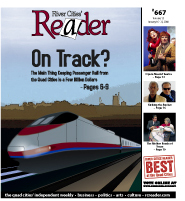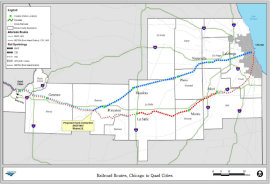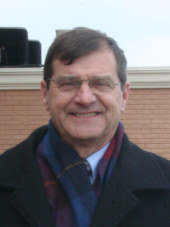 Listening
to Paul Rumler and Jim Bohnsack talk about passenger-rail service is
not unlike attending a pep rally.
Listening
to Paul Rumler and Jim Bohnsack talk about passenger-rail service is
not unlike attending a pep rally.
Rumler is the director of community and economic development for the Illinois Quad City Chamber of Commerce, and he's running for the Illinois Senate. For the purposes of this discussion, he's the chamber's staff person on passenger rail. Bohnsack is chair of both the Rock Island County Board and the Quad Cities Passenger Rail Coalition. They sound as if they're talking about trusted, reliable friends rather than capricious politics when asked to estimate the likelihood of restoring passenger-rail service to the Quad Cities after a three-decade absence.
"From one to 10 ... nine would probably be our probability," Bohnsack said of the area's chance of getting passenger-rail service to Chicago in the next few years. "There's a very slim chance we won't get it."
"Very confident," Rumler said of the area's chances. "Not fairly - very confident."
"The timing is everything, and the timing is now," Bohnsack said.
"Everything is lining up for this to occur," Rumler said.
There are certainly reasons for this optimism. A feasibility report released earlier this month by Amtrak found that infrastructure improvements to facilitate passenger rail to the Quad Cities are significantly less expensive than previously thought.
The state thinks the route is in-line with existing service in terms of riders, revenue, and cost, and it's eager to continue to expand passenger-rail service in Illinois.
And funding both from the state and federal governments looks tantalizingly close.
But Bohnsack and Rumler still seem to be forcing their confidence. This is politics, and this is bureaucracy, and sure things have a way of falling apart.
As Quad Cities-area state Representative Pat Verschoore said, "I'm not absolutely positive anything's going to happen until they give me the money."
Getting in Line
 It's
been almost a year since the topic of passenger rail was featured in
these pages. (See "Conjunction Junction," River
Cities' Reader Issue 619,
February 7-13, 2007.)
It's
been almost a year since the topic of passenger rail was featured in
these pages. (See "Conjunction Junction," River
Cities' Reader Issue 619,
February 7-13, 2007.)
Bluntly, there's been little movement but a lot of preparation for movement.
The U.S. Senate in October passed the Passenger Rail Investment & Improvement Act, which would provide Amtrak with six years of operations and capital funding. If passed by the House and signed by the president, the legislation would give the quasi-governmental corporation stability and room for growth that it has rarely had. House action could come early this year.
The Quad Cities Passenger Rail Coalition (http://www.qcrail.com) was formed in May and claims roughly 3,000 supporters.
The coalition is promoting passenger rail as an economic-development tool. Rumler said that according to a 2000 analysis tied to the Midwest Regional Rail Initiative, if a 2020 ridership goal of 230,000 were achieved in a corridor from Omaha, Nebraska, to Chicago, that would generate between between 550 and 825 jobs and between $11 million and $15 million in household income in the Quad Cities, with additional property values in the community of between $52 million to $77 million.
"It's improving access for the business traveler to get to the Quad Cities, instead of having to hop on an airplane," he said. "Passenger rail in any form is an important tool for the Quad Cities. The faster the service, the bigger the impact for the Quad Cites. ... You have to start someplace."
Beyond that, the major development was the release on January 7 of Amtrak's feasibility report to the Illinois Department of Transportation on Quad Cities-to-Chicago service. (The report summary can be downloaded at http://www.amtrak.com/pdf/QuadCitiesReport_ExecSum.pdf.)
The report is important because it establishes a clearly advantageous rail route and outlines both infrastructure and operational costs. It therefore transforms passenger rail to the Quad Cities from a concept to a concrete plan; it puts the project in line for funding.
The report explored several speed options across two routes to the Quad Cities. What's clear from the report is that the northern path (which goes through Naperville) is a cheaper alternative to the southern (going through Joliet), both in terms of infrastructure and the amount of money the state would need to pay to operate it. Amtrak chafes at the word "subsidy," but whatever the route or speed, the state would need to pay Amtrak at least $5.9 million a year to operate a line from Chicago to the Quad Cities with two daily round trips. Under any scenario, the route would generate less than $2.6 million in revenue a year - which combined with the state contribution equals the total operating cost of the route.
The northern route would also have significantly more riders, according to the study.
At 79 miles per hour - the top speed considered for the study - the northern route would require $22.7 million in capital costs, would have 110,800 riders a year, would have an end-to-end travel time of three hours, 20 minutes, and would require an annual state operational outlay of $5.9 million.
At the same speed, the southern route would require $94.1 million in capital costs, would have 84,300 riders, would have a travel time of four hours, 46 minutes, and would require an annual state outlay of $6.3 million.
The train-car-rehabilitation cost for the northern route would be $4.2 million, compared to $2.8 million for the southern route.
According to Bohnsack, there was one major surprise in the report: the capital costs for the northern route. "We were thinking $45 million, and it's down to $23 million," he said. "That was a huge surprise."
"Iowa Interstate [Railroad, whose tracks both routes would use to Wyanet] has been working to improve their own tracks over the last few years," Rumler said. "That's one reason the costs are down. Because what's good for freight rail is good for passenger rail, and vice versa."
But the lower cost associated with passenger rail in the Quad Cities is not necessarily significant in the bigger picture.
As Rumler said, with a multi-billion-dollar capital bill (the Senate last year approved one for $13.4 billion in state funds), "there's a way that we can get our equitable share of that money back to the Quad Cities," and $20 million or so probably won't make much of a difference.
"There will be money there," Bohnsack said. "There just will be."
"We have a vehicle coming in at the right time with the capital bill," Rumler said. "The funding should be happening relatively soon."
Leaving Money on the Table?
 But
why such certainty on a capital bill?
But
why such certainty on a capital bill?
That's easy: $6.2 billion.
That's the amount of federal money available to Illinois through federal transportation legislation that became law in 2005. But it requires a state match, meaning that the state could lose that money without a capital bill.
"I feel comfortable that we're going to get a capital budget," Verschoore said. "We need a capital bill so we can access that federal money that's sitting in Washington. ... Nothing would surprise me, but I can't imagine letting billions of dollars sit in Washington, D.C., because we can't get a capital bill."
Illinois' last capital bill was signed into law in 1999 and expired in 2004. That legislation used $6.3 billion in state funds to leverage $1.1 billion in local funding and $4.6 billion in federal money.
Those big numbers make it likely that the state will pass some sort of capital bill in the near future.
Just about every politician wants a capital bill to fund pet construction projects. In the Quad Cities, those include a Western Illinois University campus in Moline and the passenger-rail infrastructure. The challenge is that even with broad agreement on the need for a capital bill, the funding remains unresolved.
Verschoore said that he's been assured that passenger rail in the Quad Cities would get funded in a capital bill. "That's supposed to be in there in a capital budget if we get one," he said. "That's the understanding I'm under."
The consensus is that expanded gambling would pay for the bill, but Governor Rod Blagojevich and House Speaker Michael Madigan are forever at odds - for instance, about the board that would make critical decisions on gambling expansion.
"The speaker is saying that he, too, wants a capital bill, but his sticking point is that he wants this revised gaming board ... ," Verschoore said. "Personally I think we'll get one, but ... things can change daily down in Springfield."
Verschoore added that with legislative elections in the fall, a capital bill could fall prey to electoral politics. "If we don't get it early this spring, then I'm worried about whether we'll get one or not," he said. "The further you get along into an election year, it's hard to get things done."
And without a capital bill, Rumler said, "Amtrak passenger rail [in the Quad Cities] is in jeopardy."
The Long View
 The
capital bill is merely the most important element of bringing
passenger rail back to the Quad Cities. Without it, there would
simply be too many obstacles.
The
capital bill is merely the most important element of bringing
passenger rail back to the Quad Cities. Without it, there would
simply be too many obstacles.
That's why the Quad Cities Passenger Rail Coalition is focused on an Illinois capital bill.
"We're going to be down there [in Springfield] as much as we can telling them the importance of passenger rail to the Quad Cities," Rumler said.
The ultimate goal is for the state and federal governments to split the cost of track improvements and the rolling stock - a total of $26.9 million.
"I would be asking the state of Illinois for the entirety," Rumler said. The reason is that federal matching money isn't guaranteed, and the process of securing it might delay the start of the project. "We ask the state of Illinois for all of it; as the federal matches it, it reduces the state requirement."
Track improvements would take two construction seasons to complete, meaning that even if a capital bill passes this winter or spring, service wouldn't start until 2010 at the earliest.
But a capital bill - even one with funds for track improvements between Chicago and the Quad Cities - means little by itself.
The state Department of Transportation must initiate passenger-rail service by contracting with Amtrak and committing to fund it. Agreements would need to be forged with the owners of the railroad tracks.
A station would need to be sited and built in the Quad Cities, most likely at local expense. A study incorporating an Amtrak station is currently underway, led by the City of Moline. City Administrator Lew Steinbrecher said he hopes a recommendation on that aspect of the study will be completed by late February. He said he wasn't sure who would make the ultimate decision on the station's location, but his understanding is that it would need to be built with local money.
"It's not a no-brainer, because it is a hurdle," Rumler said of an Amtrak station. "It's not snap your fingers and it's done. It's going to take a lot of work."
The state certainly seems agreeable to Quad Cities passenger-rail service. It asked Amtrak for the feasibility study at the urging of U.S. Senator Dick Durbin.
And George Weber, acting bureau chief for the Illinois Department of Transportation Division of Public & Intermodal Transportation's Bureau of Railroads, said that the state has put an emphasis on passenger rail in recent years and "basically doubled the amount of state-sponsored service" on existing routes in October 2006.
"I think the next thing we'd like to see happen ... [is] service expansion to both Rockford/Dubuque and the Quad Cities, because they've been so long without passenger-rail service," he said. Dubuque was last served by passenger rail in 1981, while the Quad Cities have been without service since 1978.
Establishing new service, of course, "depends on funding availability," he said.
The Quad Cities Passenger Rail Coalition wants to jump ahead of Dubuque in the line for funding. "We're all vying for money," Rumler said. He noted that Amtrak's study of the Chicago-Rockford-Dubuque line estimated annual ridership at 77,500 and capital costs of $32 million - both inferior to estimates for the Quad Cities line. "The Quad Cities is a solid investment ... compared to other potential" routes, he said.
But it's not quite so simple, Weber said. Estimated ridership is a factor, he said, but "there are other parts that could swing your priority over to a corridor that might not have as much demand in ridership."
For example: "The Rockford study was done first," he said.
Expediency is also key, he said. "A lot of it depends on trying to work out some type of a construction agreement and operating scenario with the host railroad. ... If you had the money, how soon could you do the track work ... ?"
On the other hand, "the Quad Cities probably requires a little less capital," Weber said. "We would have to make the determination at the time funding becomes available."
He added that both Dubuque and the Quad Cities would have sufficient ridership to merit starting service, and would have state operating contributions that are in-line with existing Amtrak routes in Illinois. "They're both feasible," he said. "They're comparable."
Amtrak spokesperson Marc Magliari said the company doesn't have an opinion on whether a particular route would be worth the cost for the state - "That's not really our business," he said - but compared the Quad Cities to existing service between Chicago and Grand Rapids, Michigan, which is within a few track miles of the same distance.
With one daily round trip, that train has annual ridership of more than 104,000, he said. The projection for the Quad Cities is a little more than that, but spread over two daily round trips.
Grand Rapids, Magliari said, is "a pretty mature route. We've been running that for more than 20 years."
He said adult fares between the Quad Cities and Chicago would be "within a few dollars" of what it presently costs to go from Galesburg to Chicago - between $19 to $51 each way, depending on available seats on the day of purchase.
But the bigger picture about Quad Cities passenger-rail service extends beyond the the numbers to Chicago. In the long run, Rumler and Bohnsack said, the goal is to establish service between Omaha, Nebraska, and Chicago through the Quad Cities.
"That line is very well-populated," Rumler said. "That's why we see the Quad Cities as a first step, as a linchpin to continue service."
But for now, Bohnsack said, the coalition wants to keep its focus on the short run between the Chicago and the Quad Cities. "This is what we want to put our emphasis on," he said. "We don't want to get this thing clouded up to say, 'Okay, now let's go to Omaha.' Let's get this going, because we know it's two years."
Passenger Rail Cost Comparison
Route
A - Quad Cities-Naperville-Chicago
Length of Route 158.6 miles
Speed 79 mph
Proposed Scheduled Running Time 3 hours 20 minutes
"Order of Magnitude" Capital Cost $22.7 million
Coach Rehabilitation $4.2 million
Estimated Annual Ridership (two daily round-trips) 110,800
Estimated Annual Revenue $2.6 million
Estimated Annual Operating Expense $8.5 million
Estimated Annual State Contract Cost $5.9 million
Route B - Quad Cities-Joliet-Chicago
Length of Route 177.5 miles
Speed 79 mph
Proposed Scheduled Running Time 4 hours 46 minutes
"Order of Magnitude" Capital Cost $94.1 million
Coach Rehabilitation $2.8 million
Estimated Annual Ridership (two daily round-trips) 84,300
Estimated Annual Revenue $2.1 million
Estimated Annual Operating Expense $8.4 million
Estimated Annual State Contract Cost $6.3 million










